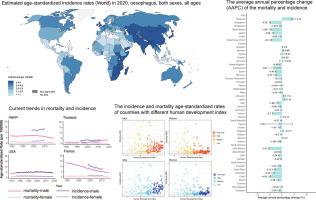Journal of Advanced Research ( IF 11.4 ) Pub Date : 2022-10-20 , DOI: 10.1016/j.jare.2022.10.007 Bolun Zhou 1 , Fenglong Bie 1 , Ruochuan Zang 1 , Moyan Zhang 1 , Peng Song 1 , Lei Liu 1 , Yue Peng 1 , Guangyu Bai 1 , Qilin Huai 1 , Yuan Li 1 , Liang Zhao 1 , Shugeng Gao 1

|
Introduction
Oesophageal cancer is a prevalent and deadly cancer around the world.
Objectives
We aimed to present a comprehensive analysis of the global geographic patterns and temporal trends in the mortality and incidence of oesophageal cancer.
Methods
The mortality and incidence data of oesophageal cancer in 2020 were obtained from the GLOBOCAN database. Based on World Health Organization (WHO) mortality database and the Cancer Incidence in Five Continents (CI5), we also retrieved the mortality and incidence age-standardized rates (ASRs) of oesophageal cancer. The average annual percentage changes (AAPCs) of mortality and incidence were calculated using the joinpoint regression analysis.
Results
Globally, 0.54 million deaths and 0.6 million new cases were identified in 2020. In the majority of countries of South America and Asia, the mortality and incidence trends have substantially decreased, but trends in European countries have varied. The prevalence in European nations varied, but the incidence in most other continents decreased dramatically. In terms of mortality, the global average rate was 5.6 per 100000, ranging from 16.7 (Malawi) to 0.28 (Belize). European countries varied in mortality, such as Norway (AAPC, male: 0.68; female: 0.89) and Ireland (AAPC, male: −0.96; female: −1.52). Most non-European countries saw large decreases in mortality, such as Singapore (AAPC, male: −4.78; female: −6.89). The elderly had more noticeable trends in mortality and incidence in most countries.
Conclusions
We have identified different trends in mortality and incidence among European countries, whereas declining trends were identified in most non-European countries. However, increasing trends were identified in specific subgroups of some countries, such as men in Thailand. For populations with rising mortality and incidence trends, more preventative efforts are required.
中文翻译:

食管癌发病率和死亡率的全球负担和时间趋势
介绍
食管癌是世界各地普遍且致命的癌症。
目标
我们的目的是对食管癌死亡率和发病率的全球地理模式和时间趋势进行全面分析。
方法
2020年食管癌死亡率和发病率数据来自GLOBOCAN数据库。基于世界卫生组织(WHO)死亡率数据库和五大洲癌症发病率(CI5),我们还检索了食管癌的死亡率和发病年龄标准化率(ASR)。使用连接点回归分析计算死亡率和发病率的平均年度百分比变化(AAPC)。
结果
2020年,全球共确定了54万例死亡和60万例新发病例。在南美洲和亚洲的大多数国家,死亡率和发病率趋势大幅下降,但欧洲国家的趋势有所不同。欧洲国家的患病率各不相同,但大多数其他大陆的发病率急剧下降。就死亡率而言,全球平均死亡率为每10万人中5.6人,范围从16.7人(马拉维)到0.28人(伯利兹)。欧洲国家的死亡率各不相同,例如挪威(AAPC,男性:0.68;女性:0.89)和爱尔兰(AAPC,男性:-0.96;女性:-1.52)。大多数非欧洲国家的死亡率大幅下降,例如新加坡(AAPC,男性:-4.78;女性:-6.89)。在大多数国家,老年人的死亡率和发病率趋势更为明显。
结论
我们发现欧洲国家的死亡率和发病率存在不同的趋势,而大多数非欧洲国家的死亡率和发病率呈下降趋势。然而,在一些国家的特定亚群体中发现了增加的趋势,例如泰国的男性。对于死亡率和发病率趋势上升的人群,需要采取更多的预防措施。











































 京公网安备 11010802027423号
京公网安备 11010802027423号